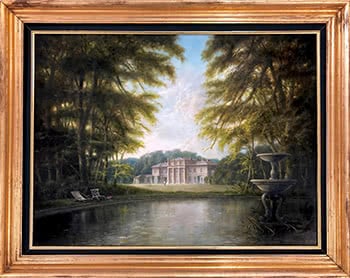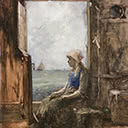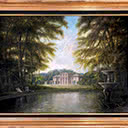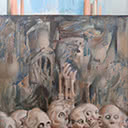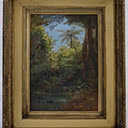Hackwood Park
61 x 81.5 cm
PROVENANCE
Collection of Viscountess Camrose Joan Yarde-Buller (Joan Berry) Hon. Joan Barbara Yarde-Buller (1908 - 97) was an English socialite, one of the Bright Young Things, a nickname given by the tabloid press to a group of bohemian young aristocrats and socialites in 1920s London.
Felix Kelly is one of New Zealand's most interesting expatriate artists. Born in Epsom in 1914 he claimed to be two years younger most of his adult life. Kelly studied briefly, and even seems to have taught drafting at Elam School of Fine Art. He was only 21 when he left New Zealand in 1935. He never returned. In London Kelly continued his New Zealand occupation of graphic design, working for Lintas, the advertising wing of Unilevers. He also freelanced as an illustrator and cartoonist, especially for Lilliput. His cartoons are not unlike those of the slightly younger Ronald Searle. After the war and the RAF, the focus of his graphic art shifted to book illustration, dust-jacket design and contributions on interior decoration to such fashion magazines as Ideal Home and Harper's Bazaar. In the 1950s and 60s he was acknowledged as one of England's top designers for the theatre, working with the likes of Sir John Gielgud and Dame Sybil Thorndike.
Kelly's ambition had always been to succeed as a painter. Emerging in the context of Surrealism and British Neo-Romanticism, he exhibited alongside important British artists such as Lucian Freud, John Piper and fellow New Zealander Frances Hodgkins. He attracted the attention of the prominent critic and writer, Herbert Read. Kelly's paintings are characterised by his interest in a world forgotten by progress, great houses falling into dilapidation, wind- blasted trees, abandoned locomotives often invested with an eerie watchfulness. Rapidly, Kelly assembled a client list resembling a page from Who's Who or De Brett's. In late career, his knowledge of architecture led to involvement in house design, most notably his collaboration on the redesign of Highgrove for the Prince of Wales.
His most celebrated project was, however, the mural cycle at Castle Howard associated with the filming of Brideshead Revisited in the 1980s. Kelly travelled a great deal. Paintings of Spain and Italy in the 1940s were followed by West African scenes in the 50s and ante-bellum houses in America's Deep South in the 60s and 70s. Trips to Russia, Thailand, India and Egypt in the 70s and 80s each led to an exhibition of exotic paintings. In late career, Kelly would execute a small sketch characterised by loose brush-work, which would then be converted into a carefully executed big-scale painting. Both types of work appear for sale from time to time. Kelly completed paintings of Auckland subjects done decades after he had left home. Auckland's West Coast beaches or Takapuna with Rangitoto beyond, or paddle-steamers on the Waitemata, were evoked with an increasing degree of fantasy well into the 1960s. A quirky humour pervades his work.
Felix Kelly has to be one of New Zealand's most individual artistic exports. A comprehensive exhibition of his earlier work, curated by Donald Bassett and mounted by the Hawke's Bay Museum and Art Gallery, toured several New Zealand centres in 2008-09. A second edition of Donald Bassett's book Fix; The Art and Life of Felix Kelly, was published in 2013.
Hackwood Park
At the time Felix Kelly painted Hackwood Park it was a large country estate with an 18th century ornamental woodland, formal lawn garden and a large detached house. Located in the rural parish of Winslade, south of Basingstoke in Hampshire, its 260 acre grounds contained a teahouse pavilion, ornamental bridge, a statue of King George I, stone urns and fountains, a coach house and stables. The estate had been owned by the rectory of Eastrop until 1223, when it became a noble's deer park. It was acquired by William Paulet, Marquess of Winchester in the 16th century. The house was built from 1683 to 1687 for a son of the fifth Marquess, Charles Paulet, created Duke of Bolton.The estate was inherited by his son, Charles Paulet, 2nd Duke of Bolton in 1699. Hackwood House remained a country seat of British nobility for centuries.
In 1936 the estate was sold to William Berry, Viscount Camrose. Lord Camrose purchased Hackwood House as a home for his family of eight children, and as a property where he could entertain his many rich, famous and influential friends away from London and Westminster. Over the years he created an atmosphere of peace and tranquillity at Hackwood where he entertained kings, princes, ambassadors, prime ministers and entertainers. During World War II Hackwood Park served as a hospital for the Canadian Army. When Lord Camrose died in 1954 the property was inherited by his son, Seymour Berry, 2nd Viscount Camrose. Viscount Camrose was the owner of Hackwood House when it was painted by Felix Kelly in 1987. He died in 1995 and his wife, Lady Camrose, the mother of business magnate Aga Khan IV, lived there until her death in 1997.

